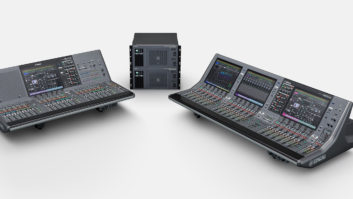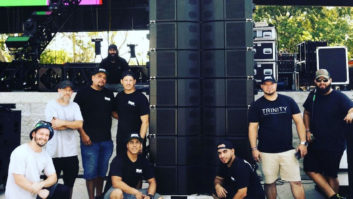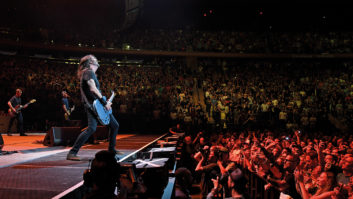Playing Madison Square Garden is a milestone in any band’s career. For The Lumineers, their recent shows there were no exception, particularly for co-founders Wesley Schultz (lead vocals, guitar) and Jeremiah Fraites (drums, percussion) who saw concerts there while growing up in nearby New Jersey. These days, the band plays arenas around the world, and the task of ensuring that the usually intimate sound of folk rock can fill a 20,000-seat venue falls to the engineering team of Josh Osmond, FOH Engineer, and Brad Galvin, monitor engineer.
Both Osmond and Galvin started touring with the band in 2013, “just after they had their accidental big hits and suddenly got incredibly popular,” laughed Osmond. The band took its time recording a follow-up album, Cleopatra, and cautiously booked a U.S. theater run before the album’s release last spring. As the year progressed, increasingly larger venues were played and that meant the tour’s PA expanded as well. “We had to plan for this to get bigger; by the time May hit, we knew we’d be doing an arena run,” said Osmond, who designed the system. “Back in April, I provided Sound Image with a spreadsheet of exactly what system each leg was going to be, growing up to this.”
The “this” for the arena run was a massive Meyer Sound system that included 10 Leo over eight Lyon per side for main hangs; 14 Lyon per side for down stage side hangs, 14 Leopard per side for upstage side hangs, 32 1100-LFC low-frequency control elements (16 flown, 12 ground-stacked L and R plus four center), six Leopard for front fills, and a Galileo loudspeaker management system.
“We had Meyer Milo for the first 2,000-5,000-seat leg, then we transitioned to Lyon as the main system with Leopard as the auxiliary hang,” said Osmond. “Leopard also ended up working as our main system in smaller venues where weight limits were restrictions. Now we have Leo as the main hang and all the other components are now complementing that. It all works together very well; with all the new horn design and delay integration, the phase response lines right up which is very important when you’re putting multiple types of speakers together in a big room like the Garden.”
While the PA morphed from leg to leg, Osmond and Galvin stuck with their respective consoles—an Avid Venue S6L and a DiGiCo SD5. Osmond has been on the S6L for more than a year now: “Coming from using a Profile previously, the leaps and bounds they’ve made has been incredibly significant,” he said. “It sounds like an analog console again, which is nice; they did a complete redesign of the preamps from the ground up. The way I program, I basically create customized fader layouts, so I can bank through the show. The workflow is so smooth; you don’t have to dig through so many pages to get to what you want.”
With a daunting Meyer Sound PA behind them, the crew included (l-r): Dave Shatto, system engineer; Cameron Whaley, audio crew chief; Matt Garrett, PA tech; Brad Galvin, monitor engineer; Marc Estrin, PA tech; and Josh Osmond, FOH/system designer.

Beyond Osmond’s practical reasons to use screenshots—muting some of the 64 inputs from the stage, various sends and so on—they also fit in with his mixing philosophy: “My mix hasn’t really changed since last May other than minor tweaks, because if you have the same gear, same console and same microphones, then your only variables are the room and the system in terms of how much you’re putting up or where it’s aiming. Most of my changes get done on the system, so when I’m mixing, nothing’s drastically different show to show.”
Osmond is a fan of the stock AAX plug-ins found on the S6L and singled out the Pro Compressor in particular, while also citing Sonnox’s Oxford Dynamics plug-in, used to compress cello, keyboard and bass; McDSP’s AE600 six-band parametric EQ which he uses on vocals; and the SPC2000 Serial Compression plug-in, applied on guitars: “It goes through the first compressor, catches the really quick transient attacks, and then the second one has a slow reaction time to keep the overall level under control.”
Next to the desk, however, was a sizable rack of outboard gear. “It’s a real luxury these days,” he readily admitted. “There’s a TC Electronic M5000 that does my snare and tom reverbs; two Bricasti M7s—the top is the vocal reverb and the bottom one is all special effect reverbs for specific songs; a Smart Research C2 used on left-right bus compression; and three Distressors—main vocal, bass and a spare. Finally, with the Summit DCL-200s, I do parallel compression on the drums over the drum subgroup, so the top one, the drums are just running through it to get the warmth and the flavor, the bottom one really squishes them, and then I blend them together and it creates this really nice, impactful drum sound without letting them overpower the mix.”
Across their current 17-month world tour, The Lumineers graduated from 2,000-seat theaters to a run through North American arenas, including New York City’s Madison Square Garden, seen here.

He wasn’t the only one with outboard units, however; Galvin useds a Rupert Neve Designs 5045 Primary Source Enhancer in monitorworld. “It’s the one thing that’s saved me with Wes’ vocal, because it drops the ambience level 6 to 9 dB for me, which is huge. There’s a threshold on it and a depth, so as long as I set that threshold right, if he’s away from the mic, it doesn’t open up. When we do line-check, I’ll take it off to make sure it’s working right and everything gets super washy because of bleed from the PA and drums. On the main stage, it’s helpful, but on the B Stage, it’s amazing.”
The B-stage was a key factor in the arena shows, as the band played 100 feet in front of the main-stage PA with no B-stage hangs to localize the sound. “Having five open vocal mics at 100 dB in front of the PA is never ideal,” said Osmond, “which is part of why the Shure KSM8s have been fantastic for vocals because they have just such great rejection and a very good SPL-to-Feedback ratio.”
Nonetheless, Galvin had to take extra precautions during the B-stage set: “The problem is the one that faces directly into the PA—when Wes is singing into it, if I leave that open in between lines, it kills me with the slapback off the kick drum and the delay of everything coming to it, so I have to know all the lines of the song [and mute it in between]. He has this thing where he’ll come up to the mic and hit it early; luckily I know that so I can hit it just before he does.”
So for a rootsy, Americana band that revels in creating a simple sound, there’s a lot of machinery at hand to help make that happen. “In general, it is a fairly organic-sounding album—not a lot of bells and whistles, not a lot of flash,” said Osmond. “Ironically, Brad and I wind up doing a lot of fairly complex things to achieve that same organic-ness, because at a certain point, when the technology grows but the music doesn’t, you almost have to work backwards to get to what you’re going for. We wanted to create something that could put on a bigger-sounding show.”
They’ll get that opportunity as the year progresses; with the arena tour now complete, the Lumineers and engineers will cross the globe, visiting everywhere from Australia to South Africa, before hitting U.S. festivals this summer and perhaps the ultimate test for an expansive folk rock sound: opening for U2 on a baker’s dozen of stadium shows.
Sound Image
sound-image.com
Meyer Sound
meyersound.com
Avid
avid.com
This article originally appeared as “Live Sound Showcase: Engineers of the Lumineers” in the April, 2017 issue of Pro Sound News.







